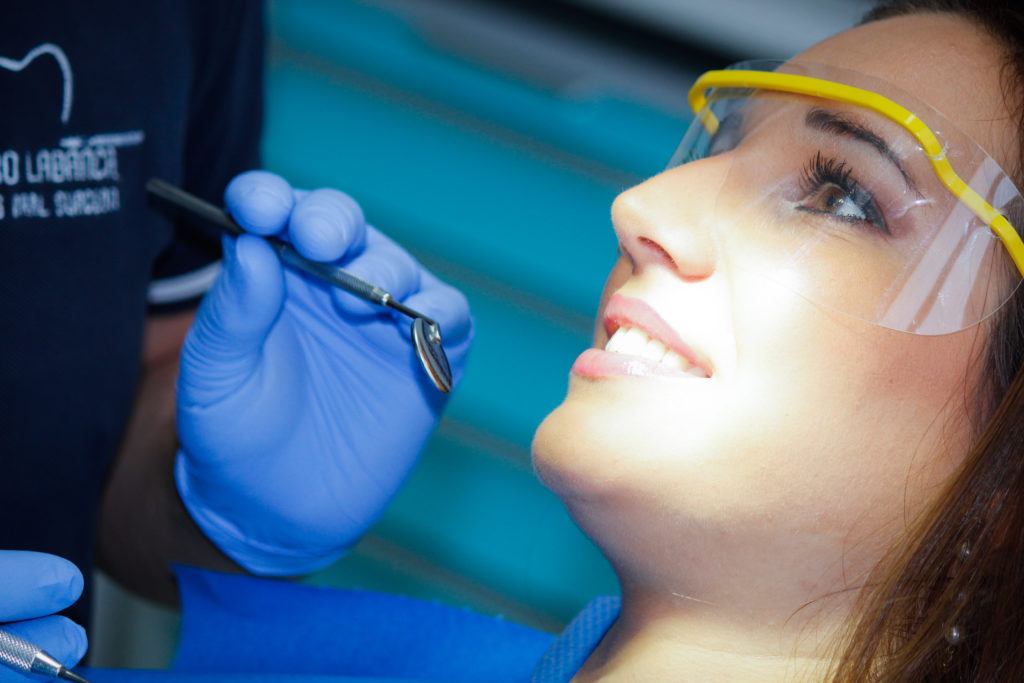HYGIENE AND PROPHYLAXIS
Instructions for oral hygiene
These represent all the manoeuvres which should be performed at home to ensure a level of hygiene compatible with the health of the oral cavity. A good hygiene at home is achieved with the correct use of the toothbrush, performing dental-gingival vertical movements (red-gum, white-tooth) while antero-posterior and lateral movements are made on the occlusal surfaces. You should not brush your teeth immediately after eating or drinking acidic drinks (orange juice, coca-cola, lemon etc) which due to their acidity cause a transient weakening of the enamel. Last but not least, it is recommended to clean the dorsal surface of the tongue without toothpaste (special tools exist for this purpose) that due to its shape it retains food residues and bacteria that may cause halitosis. To complete the cleaning of our teeth it is recommended to use dental floss, which in addition to cleaning the interdental surfaces, it is an aid to early diagnosis of interproximal caries (if you were worried). After using dental floss, it may be appropriate to apply an additional final step using the toothbrush to remove any residues moved out by the floss. The use of mouthwash helps to complete our cleaning and furthermore ensures a clean fresh breath.
The manual toothbrush should be changed as soon as the bristles appear broad and worn, approximately once a month.
The existing electric toothbrushes offer great help and are often very effective and appropriate; they also require the replacement of the head even if it is not showing signs of wear.
Ablation of calculus
Supragingival calculus removal with the aid of ultrasonic scalers, which have the ability to erode the tartar without damaging the enamel surface. Thus there is no fear of damaging the teeth by removing the tartar.
Buffing or Polishing
Polishing of dental surfaces by means of prophylaxis paste, as well as for the quick preliminary polishing of fillings.
Removal of exogenous pigmentation
The surface of the enamel can be characterized by exogenous pigmentations due mostly to cases of calculus, stains of caffeine, nicotine, etc.
In more rare cases, the pigmentation may be due to alterations of the tooth during embryogenesis (initial development phase of the tooth) as: enamel hypoplasia or amelogenesis imperfecta.
Topical application of fluoride
The fluoride exerts its action by acting either directly on the mineral component of the tooth or on plaque bacteria. The use of fluoride gel with equipment that allows us to fix the fluoride on the surface of the enamel is generally recommended for patients with a high risk of caries. Fluoride-releasing reconstruction materials have also been introduced into the practice (compomer, glass ionomer cements), that are particularly suitable for conservative treatments (fillings) in decayed deciduous teeth, especially for patients with a high risk of caries.
Topical application of antiseptic agents
Consists in the application of antiseptic and/or antibiotic substances, indicated for periodontal diseases (of gums) or after surgery to promote healing or to prevent the growth of bacteria.
Teeth whitening with lamp
In order to lighten the colour shade of your teeth it is possible to use peroxide based products (hydrogen peroxide or carbamide), which have an oxidant action and whiten even the more yellowed teeth, or remove those white stains sometimes present especially on the front incisors. This gel applied on the teeth is exposed to a halogen beam that activates a chemical reaction that favours the penetration of the peroxide through the enamel prisms.
Endodontic whitening
A non-vital (or compromised) tooth can sometimes present a colour change, becoming darker and causing unpleasant aesthetic problems, especially if it is in the group of front teeth. This colour change is caused by a bleeding pulp, or degeneration of the pulp due to a trauma or from using endodontic cements that contain coloured pigments and more generally, causing the loss of the tooth’s transparency and its inability to properly reflect the light.
This technique is called “walking bleach” and consists of the insertion of bleaching peroxide products within the pulp chamber, capable of oxidizing pigmented substances. The aesthetic result is generally obtained in 2-5 sessions
Sealing
A procedure that is recommended in order to preserve teeth, milk-teeth and not only, against the formation of cariogenic processes. A slow-release fluoride liquid resin is applied to the grooves of the premolars and molars which protects the enamel from future caries. It is a very useful active and mechanic form of prevention against the risk of dental caries.
Root planning
Sub-gingival calculus removal at the level of periodontal pockets; it can be performed with local anaesthesia.
Root planning with an open flap
Similar to the previous procedure, but performed doing a flap and moving the soft tissue away from the residual bone. This operation is required when the periodontal pockets reach a certain depth that prevents the complete cleaning using the previous methods. It is a surgical procedure and as such, it must be performed by a dentist who is appropriately trained for this treatment.

